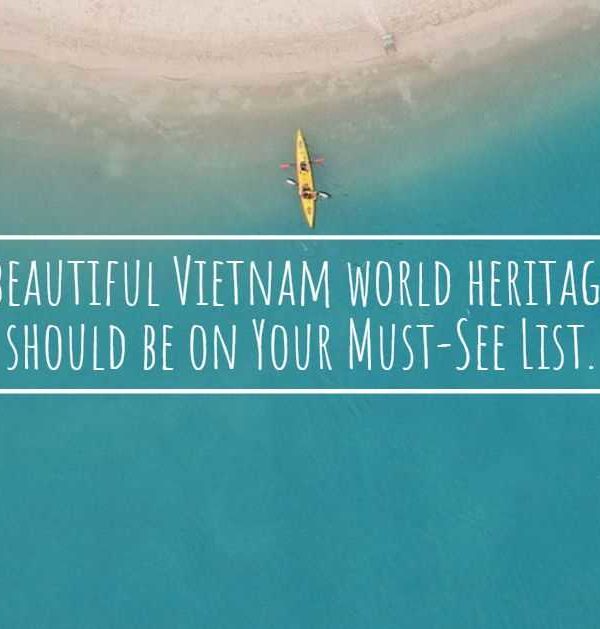In this article, we will recommend you the Top 7 Vietnam World Heritage Sites should be on your must-see list when you travel to Vietnam.
The cultural heritage of the countries in the world is not only proof of a beautiful country but it is also associated with the history of that nation. In Vietnam, too, with rich and diverse natural resources and a huge and unique cultural treasure spanning 4,000 years of national history, all of which contribute to making Vietnam one of world-famous tourist countries with 22 heritage sites honored by UNESCO.
Dong Van Karst Plateau Geopark

Dong Van rock plateau is a rock plateau located on four districts of Quan Ba, Yen Minh, Dong Van and Meo Vac of Ha Giang province, Vietnam. Dong Van rock plateau was recognized as a Global Geopark in 2010 and this is the only title in Vietnam and the second in Southeast Asia.
Halong Bay

The bay has a total area of 1553 km2 including 1969 islands, large and small, concentrated in the two main areas of the southeast region of Bai Tu Long Bay and the southwest region of Ha Long Bay. Hundreds of rocky islands, each with a very different shape. Not only is the UNESCO World Heritage Site twice (1994 and 2000), Ha Long Bay has been voted as one of the 7 new natural wonders of the world and is always on the list of the most beautiful Bays in the world.
Trang An Scenic Landscape Complex

Trang An Scenic Landscape Complex in Ninh Binh is not only the most important and prominent landscape in the North of Vietnam but also recognized by UNESCO as a world heritage site. With millions of years of limestone mountains, valleys, caves, lakes, ecosystems and mangroves, Trang An Ninh Binh tourist area attracts many visitors each year. In Trang An heritage complex, there are main tourist areas such as Trang An eco-tourism area, Tam Coc-Bich Dong tourist area, Hoa Lu ancient capital historical and cultural relic area and Hoa Lu special-use primeval forest… Linking these tourist areas is Hoa Lu special-use forest on limestone mountains and systems of rivers, lakes, and lagoons with an area of about 12,000 ha.
Hue Imperial Citadel complex

Located along the banks of the Perfume River and some surrounding areas of Thua Thien – Hue Province, the ancient vestige complex of Hue is the first heritage site of Vietnam recognized by UNESCO in December 1993.
Prominent in the complex of Hue ancient ruins are three citadels: Peripheral citadel, Imperial Citadel and Forbidden City with an architectural style which is a harmonious combination of Eastern and Western architectural elite, placed in amazing natural scenery with Ngu Binh Mountain, Huong Giang river …. In the western part of the citadel along the Perfume River, there is a system of tombs of the Nguyen kings. Today, the ancient capital of Hue still retains tangible and intangible cultural heritages containing many values symbolizing the intellect and soul of the Vietnamese.
Hoian Ancient Town

Hoi An Ancient Town is an ancient town located downstream of Thu Bon River, in the coastal plain of Quang Nam province, about 30km south of Da Nang city which is recognized as World Cultural Heritage in 1999.
Hoi An Ancient Town is always at the top of the list of tourist destinations in Vietnam for many reasons. This small town is the intersection of Eastern and Western cultures; It combines the quintessence of Vietnamese, Chinese, Japanese and European countries in both cuisine and architecture to the traditions of the local people. Along with charming nature, convenient location, Hoi An is always chosen by many tourists when visiting the Central of Vietnam.
My Son Hollyland

My Son Sanctuary is located in Duy Phu commune, Duy Xuyen district, Quang Nam province, a complex of many Cham Pa temples located in a valley about 2 km in diameter surrounded by hills and mountains. In 1999, My Son Sanctuary was recognized as a World Heritage Site by UNESCO. In Vietnam, the Government also agreed to place this place in the list of 23 national relics ranked particularly important for conservation.
Phong Nha – Ke Bang National Park

Phong Nha – Ke Bang National Park is located in Quang Binh Province – Central Vietnam with a total area of 343,300ha. In addition to the value of geological history, topography, Phong Nha – Ke Bang is also endowed with nature for mysterious, majestic landscapes, typically Son Doong cave – the largest natural cave in the world. Phong Nha – Ke Bang National Park also has a diverse flora and fauna system, many of which are rare and valuable species listed in Vietnam Red Book and World Red Book.


9 thoughts on “Most beautiful Vietnam world heritage sites should be on Your Must-See List”